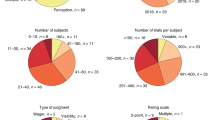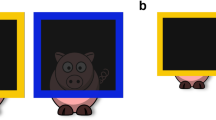Abstract
Decades of research indicate that some of the epistemic practices that support scientific enquiry emerge as part of intuitive reasoning in early childhood. Here, we ask whether adults and young children can use intuitive statistical reasoning and metacognitive strategies to estimate how much information they might need to solve different discrimination problems, suggesting that they have some of the foundations for ‘intuitive power analyses’. Across five experiments, both adults (N = 290) and children (N = 48, 6–8 years) were able to precisely represent the relative difficulty of discriminating populations and recognized that larger samples were required for populations with greater overlap. Participants were sensitive to the cost of sampling, as well as the perceptual nature of the stimuli. These findings indicate that both young children and adults metacognitively represent their own ability to make discriminations even in the absence of data, and can use this to guide efficient and effective exploration.
This is a preview of subscription content, access via your institution
Access options
Access Nature and 54 other Nature Portfolio journals
Get Nature+, our best-value online-access subscription
$29.99 / 30 days
cancel any time
Subscribe to this journal
Receive 12 digital issues and online access to articles
$119.00 per year
only $9.92 per issue
Buy this article
- Purchase on Springer Link
- Instant access to full article PDF
Prices may be subject to local taxes which are calculated during checkout








Similar content being viewed by others
Data availability
The data that support the findings of this study are available on the Open Science Foundation project page found at https://osf.io/gdp68. Source data are provided with this paper.
Code availability
Code used for data analysis is available from the corresponding author upon request.
References
Saffran, J. R., Aslin, R. N. & Newport, E. L. Statistical learning by 8-month-old infants. Science 274, 1926–1928 (1996).
Johnson, M. H., Posner, M. I. & Rothbart, M. K. Components of visual orienting in early infancy: contingency learning, anticipatory looking, and disengaging. J. Cogn. Neurosci. 3, 335–344 (1991).
Marcus, G. F., Vijayan, S., Rao, S. B. & Vishton, P. M. Rule learning by seven-month- old infants. Science 283, 77–80 (1999).
Téglás, E. et al. Pure reasoning in 12-month-old infants as probabilistic inference. Science 332, 1054–1059 (2011).
Xu, F. & Denison, S. Statistical inference and sensitivity to sampling in 11-month-old infants. Cognition 112, 97–104 (2009).
Kidd, C., Piantadosi, S. T. & Aslin, R. N. The Goldilocks effect: human infants allocate attention to visual sequences that are neither too simple nor too complex. PLoS ONE 7, e36399 (2012).
Stahl, A. E. & Feigenson, L. Observing the unexpected enhances infants’ learning and exploration. Science 348, 91–94 (2015).
Gweon, H., Tenenbaum, J. B. & Schulz, L. E. Infants consider both the sample and the sampling process in inductive generalization. Proc. Natl Acad. Sci. USA 107, 9066–9071 (2010).
Bullock, M., Gelman, R. & Baillargeon, R. in The Developmental Psychology of Time (ed. Friedman, W. J.) 209–254 (Academic Press, 1982).
Saxe, R., Tenenbaum, J. & Carey, S. Secret agents: Inferences about hidden causes by 10-and 12-month-old infants. Psychological Sci. 16, 995–1001 (2005).
Bonawitz, E. B., van Schijndel, T. J., Friel, D. & Schulz, L. Children balance theories and evidence in exploration, explanation, and learning. Cogn. Psychol. 64, 215–234 (2012).
Legare, C. H. Exploring explanation: explaining inconsistent evidence informs exploratory, hypothesis-testing behavior in young children. Child Dev. 83, 173–185 (2012).
Cook, C., Goodman, N. D. & Schulz, L. E. Where science starts: spontaneous experiments in preschoolers’ exploratory play. Cognition 120, 341–349 (2011).
Sobel, D. M., Tenenbaum, J. B. & Gopnik, A. Children’s causal inferences from indirect evidence: backwards blocking and Bayesian reasoning in preschoolers. Cogn. Sci. 28, 303–333 (2004).
Sobel, D. M. & Kushnir, T. Knowledge matters: how children evaluate the reliability of testimony as a process of rational inference. Psychological Rev. 120, 779 (2013).
Marazita, J. M. & Merriman, W. E. Young children’s judgment of whether they know names for objects: the metalinguistic ability it reflects and the processes it involves. J. Mem. Lang. 51, 458–472 (2004).
Patterson, C. J., Cosgrove, J. M. & O’Brien, R. G. Nonverbal indicants of comprehension and noncomprehension in children. Developmental Psychol. 16, 38 (1980).
Balcomb, F. K. & Gerken, L. Three-year-old children can access their own memory to guide responses on a visual matching task. Developmental Sci. 11, 750–760 (2008).
Lyons, K. E. & Ghetti, S. I don’t want to pick! Introspection on uncertainty supports early strategic behavior. Child Dev. 84, 726–736 (2013).
Hembacher, E. & Ghetti, S. Don’t look at my answer: subjective uncertainty underlies preschoolers’ exclusion of their least accurate memories. Psychological Sci. 25, 1768–1776 (2014).
Kim, S., Paulus, M., Sodian, B. & Proust, J. Young children’s sensitivity to their own ignorance in informing others. PLoS ONE 11, e0152595 (2016).
Ghetti, S., Hembacher, E. & Coughlin, C. A. Feeling uncertain and acting on it during the preschool years: a metacognitive approach. Child Dev. Perspect. 7, 160–165 (2013).
Coughlin, C., Hembacher, E., Lyons, K. E. & Ghetti, S. Introspection on uncertainty and judicious help-seeking during the preschool years. Developmental Sci. 18, 957–971 (2015).
Lyons, K. E. & Ghetti, S. The development of uncertainty monitoring in early childhood. Child Dev. 82, 1778–1787 (2011).
Paulus, M., Proust, J. & Sodian, B. Examining implicit metacognition in 3.5-year-old children: an eye-tracking and pupillometric study. Front. Psychol. 4, 145 (2013).
Call, J. & Carpenter, M. Do apes and children know what they have seen? Anim. Cognition 3, 207–220 (2001).
Chouinard M. M. Children’s questions: a mechanism for cognitive development. Monogr. Soc. Res. Child Dev. https://doi.org/10.1111/j.1540-5834.2007.00412.x (2007).
Whitebread, D. et al. The development of two observational tools for assessing meta-cognition and self-regulated learning in young children. Metacognition Learn. 4, 63–85 (2009).
Destan, N., Hembacher, E., Ghetti, S. & Roebers, C. M. Early metacognitive abilities: the interplay of monitoring and control processes in 5-to 7-year-old children. J. Exp. Child Psychol. 126, 213–228 (2014).
Flavell, J. H., Friedrichs, A. G. & Hoyt, J. D. Developmental changes in memorization processes. Cogn. Psychol. 1, 324–340 (1970).
Koriat, A., Sheffer, L. & Ma’ayan, H. Comparing objective and subjective learning curves: judgments of learning exhibit increased underconfidence with practice. J. Exp. Psychol.: Gen. 131, 147 (2002).
Metcalfe, J. & Finn, B. Metacognition and control of study choice in children. Metacognition Learn. 8, 19–46 (2013).
Hofer, B. K. & Pintrich, P. R. The development of epistemological theories: beliefs about knowledge and knowing and their relation to learning. Rev. Educ. Res. 67, 88–140 (1997).
Lockl, K. & Schneider, W. The effects of incentives and instructions on children’s allocation of study time. Eur. J. Developmental Psychol. 1, 153–169 (2004).
Roebers, C. M. & Howie, P. Confidence judgments in event recall: developmental progression in the impact of question format. J. Exp. Child Psychol. 85, 352–371 (2003).
Schneider, W. & Pressley, M. Memory Development Between Two and Twenty (Psychology Press, 2013).
Veenman, M. V., Van Hout-Wolters, B. H. & Afflerbach, P. Metacognition and learning: conceptual and methodological considerations. Metacognition Learn. 1, 3–14 (2006).
Siegel, M. H., Magid, R. W., Pelz, M., Tenenbaum, J. B. & Schulz, L. E. Children’s exploratory play tracks the discriminability of hypotheses. Nat. Commun. 12, 3598 (2021).
Xu, F. & Garcia, V. Intuitive statistics by 8-month-old infants. Proc. Natl Acad. Sci. USA 105, 5012–5015 (2008).
Vul, E., Goodman, N., Griffiths, T. L. & Tenenbaum, J. B. One and done? Optimal decisions from very few samples. Cogn. Sci. 38, 599–637 (2014).
Zhang, H. & Maloney, L. T. Ubiquitous log odds: a common representation of probability and frequency distortion in perception, action, and cognition. Front. Neuroscience https://doi.org/10.3389/fnins.2012.00001 (2012).
Tversky, A. & Kahneman, D. Belief in the law of small numbers. Psychological Bull. 76, 105–110 (1971).
Tversky, A. & Kahneman, D. Judgment under uncertainty: heuristics and biases. Science 185, 1124–1131 (1974).
Jones, P. R. et al. Efficient visual information sampling develops late in childhood. J. Exp. Psychol.: Gen. 148, 1138–1152 (2019).
Acknowledgements
Thank you to the Boston Children’s Museum and the families who participated in this research. This material is based on work supported by the National Science Foundation Graduate Research Fellowship under grant no. 1745302 to M.C.P., and National Science Foundation grant no. 1231216 to L.E.S. The funders had no role in study design, data collection and analysis, decision to publish or preparation of the manuscript.
Author information
Authors and Affiliations
Contributions
M.C.P. and L.E.S. conceived and designed the behavioural studies. K.R.A. and J.B.T. contributed the computational modelling. The manuscript was written primarily by M.C.P. and L.E.S. with input and comments from K.R.A.
Corresponding author
Ethics declarations
Competing interests
The authors declare no competing interests.
Peer review
Peer review information
Nature Human Behaviour thanks Yingying Yang, Matteo Lisi and the other, anonymous, reviewer(s) for their contribution to the peer review of this work. Peer reviewer reports are available.
Additional information
Publisher’s note Springer Nature remains neutral with regard to jurisdictional claims in published maps and institutional affiliations.
Supplementary information
Source data
Source Data Fig. 1
Model output data.
Source Data Fig. 3
Statistical source data.
Source Data Fig. 4
Statistical source data.
Source Data Fig. 5
Statistical source data.
Source Data Fig. 6
Statistical source data.
Source Data Fig. 7
Statistical source data.
Source Data Fig. 8
Statistical source data.
Rights and permissions
About this article
Cite this article
Pelz, M.C., Allen, K.R., Tenenbaum, J.B. et al. Foundations of intuitive power analyses in children and adults. Nat Hum Behav 6, 1557–1568 (2022). https://doi.org/10.1038/s41562-022-01427-2
Received:
Accepted:
Published:
Issue Date:
DOI: https://doi.org/10.1038/s41562-022-01427-2



